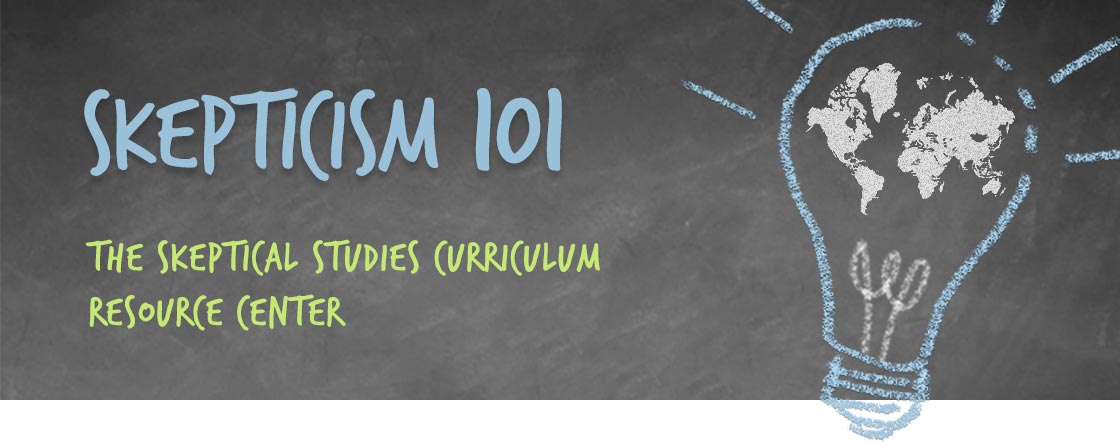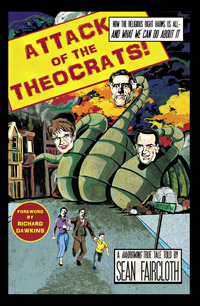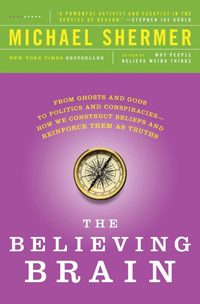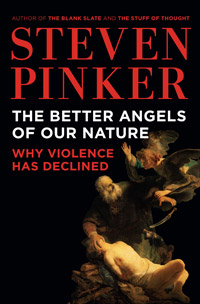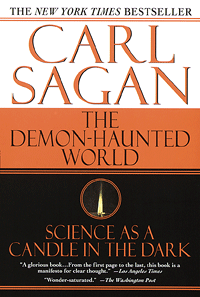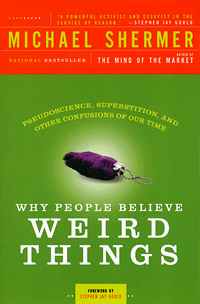You Are Browsing Resources
for the Academic Discipline of:
history
This PowerPoint is part of a course titled, “Science Skepticism & Weird Behavior.”
SCIENCE, THEORY, AND PARADIGM SHIFTS
There are three lectures in this series, they are intended to educate students about the nature of science and the power of natural explanations. This is accomplished through the concept of the Paradigm Shift. The discussion begins with non-scientific views of nature and then follows the development of scientific views and how/why they changed over many hundreds of years. This post concerns the third lecture in the series.
Examples of paradigm shifts covered in the lecture series include:
- the shift from supernatural to nature interpretations of comets.
- the shift from astrology (Ptolemaic) to astronomy (Copernican revolution).
- the development of Copernican cosmology to a synthesis called Newtonian physics.
- the shift from Newtonian physics into Relativity Theory.
Lecture 3 – PARADIGM SHIFT 3
This lecture is a continuation of the previous lecture where the paradigm shift from Newtonian physics to the theory of relativity is discussed. The lecture ends with a discussion of the cosmic microwave background and what the various differences in temperature could mean.
DOWNLOAD THIS RESOURCE
(16.5 MB Powerpoint Presentation)
Lecture 1 – PARADIGM SHIFT 1
You can find the first lecture in the series here.
Lecture 2 – PARADIGM SHIFT 2
You can find the second lecture in the series here.
This PowerPoint is part of a course titled, “Science Skepticism & Weird Behavior.”
SCIENCE, THEORY, AND PARADIGM SHIFTS
There are three lectures in this series, they are intended to educate students about the nature of science and the power of natural explanations. This is accomplished through the concept of the Paradigm Shift. The discussion begins with non-scientific views of nature and then follows the development of scientific views and how/why they changed over many hundreds of years. This post concerns the second lecture in the series.
Examples of paradigm shifts covered in the lecture series include:
- the shift from supernatural to nature interpretations of comets.
- the shift from astrology (Ptolemaic) to astronomy (Copernican revolution).
- the development of Copernican cosmology to a synthesis called Newtonian physics.
- the shift from Newtonian physics into Relativity Theory.
Lecture 2 – PARADIGM SHIFT 2
This lecture introduces the concept of scientific paradigm shifts, the concept of empiricism, the concept of anomalies and the concept of synthesis. These concepts are discussed in the context of a paradigm shift called the Copernican and the Newtonian Revolutions.
DOWNLOAD THIS RESOURCE
(20.6 MB Powerpoint Presentation)
Lecture 1 – PARADIGM SHIFT 1
You can find the first lecture in the series here.
Lecture 3 – PARADIGM SHIFT 3
You can find the third lecture in the series here.
This PowerPoint is part of a course titled, “Science Skepticism & Weird Behavior.”
SCIENCE, THEORY, AND PARADIGM SHIFTS
There are three lectures in this series, they are intended to educate students about the nature of science and the power of natural explanations. This is accomplished through the concept of the Paradigm Shift. The discussion begins with non-scientific views of nature and then follows the development of scientific views and how/why they changed over many hundreds of years. This post concerns the first lecture in the series.
Examples of paradigm shifts covered in this lecture series include:
- the shift from supernatural to nature interpretations of comets.
- the shift from astrology (Ptolemaic) to astronomy (Copernican revolution).
- the development of Copernican cosmology to a synthesis called Newtonian physics.
- the shift from Newtonian physics into Relativity Theory.
Lecture 1 – PARADIGM SHIFT I
This lecture demonstrates the power of natural explanations over supernatural ones. The main topic is about the various ways that people throughout history have interpreted comets when they appeared in the sky. The lecture beings with a discussion about what we currently know about comets and then transitions into what ancients believed.
Two examples are given initially whereby major players in history misinterpreted the appearance of a famous comet (Halley’s comet) as a sign from god to fulfill their destiny. The first example was Genghis Cohn who began his invasion of the west after comet Halley appeared in the sky, the second was William the Conqueror who invaded England in 1066 after seeing comet Halley appear in the sky.
A third and final example is given whereby a person saw Halley’s comet in the sky but didn’t leap to a supernatural conclusion. This person was Sir Issac Newton and his interpretation of the comet was quite different because he assumed that the comet was natural. By asking simple, empirical, questions about the nature of the comet, Newton, with the help of Edmund Halley, was able to make a prediction the comet would one day return. Comet Halley did return just as Newton and Halley predicted thus proving that comets were not supernatural but are 100% natural just like the planets and other celestial bodies.
DOWNLOAD THIS RESOURCE
(6.3 MB Powerpoint Presentation)
Lecture 2 – PARADIGM SHIFT 2
You can find the second lecture in the series here.
Lecture 3 – PARADIGM SHIFT 3
You can find the third lecture in the series here.
This course was taught at Chapman University during the spring 2013 semester as an undergraduate course.
Excerpt from Syllabus
This course addresses the evolutionary origins of morality, the developmental psychology of moral emotions, the historical course of moral development throughout the history of civilization, and the forces that have bent the arc of the moral universe toward truth, justice, freedom, and prosperity.
Students will look at how the arc of the moral universe bends toward truth, justice, freedom, and prosperity thanks to science the type of thinking that involves reason, rationality, empiricism, and skepticism. The Scientific Revolution led by Copernicus, Galileo, and Newton was so world-changing that thinkers in other fields consciously aimed at revolutionizing the social, political, and economic worlds using the same methods of science. This led to the Age of Reason and the Enlightenment, which in turn created the modern secular world of democracies, rights, justice, and liberty.
DOWNLOAD THIS RESOURCE
(209 kb PDF)
This book was required reading for Dr. Innes Mitchell’s course, “Perspectives on Atheism” taught at St. Edwards University during spring 2012.

The religious right is gaining enormous power in the United States, thanks to a well-organized, media-savvy movement with powerful friends in high places. Yet many Americans — both observant and secular — are alarmed by this trend, especially by the religious right’s attempts to erase the boundary between church and state and re-make the U.S. into a Christian nation. But most Americans lack the tools for arguing with the religious right, especially when fundamentalist conservatives claim their tradition started with the Framers of The Constitution. Fighting Words is a a tool-kit for arguing, especially for those of us who haven’t read the founding documents of this nation since grade school. Robin Morgan has assembled a lively, accessible, eye-opening primer and reference tool, a “verbal karate” guide, revealing what the Framers and many other leading Americans really believed — in their own words — rescuing the Founders from images of dusty, pompous old men in powdered wigs, and resurrecting them as the revolutionaries they truly were: a hodgepodge of freethinkers, Deists, agnostics, Christians, atheists, and Freemasons — and they were radicals as well.—Amazon
BUY THIS BOOK
from Amazon
This book was required reading for Dr. Innes Mitchell’s course, “Perspectives on Atheism” taught at St. Edwards University during spring 2012.
While much of the public debate in the United States over church-state issues has focused on the construction of nativity scenes in town squares and the addition of “under God” to the Pledge, Faircloth, who served ten years in the Maine legislature and is now Director of Strategy & Policy for the U.S. Richard Dawkins Foundation, moves beyond the symbolism to explore the many ways federal and state legal codes privilege religion in law.
Faircloth speaks around the nation on the Constitution, separation of church and state, and secular strategy. Faircloth also served for a decade in the Maine legislature, successfully spearheading over thirty laws. In his last term in office, Faircloth was elected Majority Whip by his caucus colleagues. —Amazon
BUY THIS BOOK
from Amazon
This book was required reading for the following courses: (1) “Skepticism 101: How to Think Like a Scientist (Without Being a Geek)” taught by Michael Shermer during the fall 2011 and (2) “Evolution, Economics, and the Brain” taught by Michael Shermer during the spring 2012.
In this, his magnum opus, Dr. Michael Shermer presents his comprehensive theory on how beliefs are born, formed, nourished, reinforced, challenged, changed, and extinguished. This book synthesizes Dr. Shermer’s 30 years of research to answer the questions of how and why we believe what we do in all aspects of our lives, from our suspicions and superstitions to our politics, economics, and social beliefs. In this book Dr. Shermer is interested in more than just why people believe weird things, or why people believe this or that claim, but in why people believe anything at all. His thesis is straightforward:
“We form our beliefs for a variety of subjective, personal, emotional, and psychological reasons in the context of environments created by family, friends, colleagues, culture, and society at large; after forming our beliefs we then defend, justify, and rationalize them with a host of intellectual reasons, cogent arguments, and rational explanations. Beliefs come first, explanations for beliefs follow.”
Dr. Shermer also provides the neuroscience behind our beliefs. The brain is a belief engine. From sensory data flowing in through the senses the brain naturally begins to look for and find patterns, and then infuses those patterns with meaning. The first process Dr. Shermer calls patternicity: the tendency to find meaningful patterns in both meaningful and meaningless data. The second process he calls agenticity: the tendency to infuse patterns with meaning, intention, and agency.
We can’t help believing. Our brains evolved to connect the dots of our world into meaningful patterns that explain why things happen. These meaningful patterns become beliefs. Once beliefs are formed the brain begins to look for and find confirmatory evidence in support of those beliefs, which adds an emotional boost of further confidence in the beliefs and thereby accelerates the process of reinforcing them, and round and round the process goes in a positive feedback loop of belief confirmation. Dr. Shermer outlines the numerous cognitive tools our brains engage to reinforce our beliefs as truths and to insure that we are always right.
Interlaced with his theory of belief, Dr. Shermer provides real-world examples of belief from all realms of life, and in the end he demonstrates why science is the best tool ever devised to determine whether or not a belief matches reality. —Shop Skeptic
BUY THIS BOOK
from Shop Skeptic
Michael Shermer gave a lecture on this book at the California Institute of Technology.
BUY THE DVD
from Shop Skeptic
This book was required reading for the following course: “Evolution, Economics, and the Brain” taught by Michael Shermer during the spring 2011 and 2012 semesters.
Faced with the ceaseless stream of news about war, crime, and terrorism, one could easily think we live in the most violent age ever seen. Yet as New York Times bestselling author Steven Pinker shows in this startling and engaging new work, just the opposite is true: violence has been diminishing for millennia and we may be living in the most peaceful time in our species’s existence. For most of history, war, slavery, infanticide, child abuse, assassinations, pogroms, gruesome punishments, deadly quarrels, and genocide were ordinary features of life. But today, Pinker shows (with the help of more than a hundred graphs and maps) all these forms of violence have dwindled and are widely condemned. How has this happened?
This groundbreaking book continues Pinker’s exploration of the essence of human nature, mixing psychology and history to provide a remarkable picture of an increasingly nonviolent world. The key, he explains, is to understand our intrinsic motives- the inner demons that incline us toward violence and the better angels that steer us away-and how changing circumstances have allowed our better angels to prevail. Exploding fatalist myths about humankind’s inherent violence and the curse of modernity, this ambitious and provocative book is sure to be hotly debated in living rooms and the Pentagon alike, and will challenge and change the way we think about our society. —Amazon
BUY THIS BOOK
from Amazon
This book was required reading for Martin Bridgstock’s course, “Skepticism, Science & the Paranormal” taught at Griffith University during the spring 2011 semester.
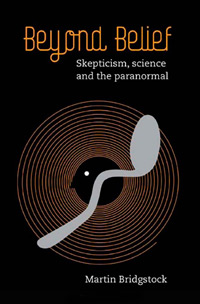
Whether ghosts, astrology or ESP, up to 80 per cent of the population believes in one or more aspects of the paranormal. Such beliefs are entertaining, and it is tempting to think of them as harmless. However, there is mounting evidence that paranormal beliefs can be dangerous – cases of children dying because parents rejected orthodox medicine in favour of alternative remedies, and ‘psychics’ who trade on the grief of the bereaved for personal profit and gain. Expenditure on the paranormal runs into billions of dollars each year. In Beyond Belief: Skepticism, Science and the Paranormal Martin Bridgstock provides an integrated understanding of what an evidence-based approach to the paranormal – a skeptical approach – involves, and why it is necessary. Bridgstock does not set out to show that all paranormal claims are necessarily false, but he does suggest that we all need the analytical ability and critical thinking skills to seek and assess the evidence for paranormal claims. —Amazon
BUY THIS BOOK
from Amazon
This presentation depicts the history of academic thought on voter turnout and shows how recent neuroscience has changed the prevailing wisdom on the subject. While political science scholars of the 70’s and 80’s believed voters were rational calculators, neuroscience has shown that emotion and narrative play a strong role in this process. This presentation was created by Michael Mermelstein for Dr. Michael Shermer’s course, “Evolution, Economics & the Brain” taught at Claremont Graduate University during the spring 2012 semester.
DOWNLOAD THIS RESOURCE
(182 kb Powerpoint Presentation)
This book was required reading for the following courses: (1) “Skepticism 101: How to Think Like a Scientist Without Being a Geek” taught by Michael Shermer, (2) “Weird Science” taught by John Donovan, (3) “The Scientific Method: Critical & Creative Thinking” taught by Stephen Sekula et al., and (4) “Studies in Behavior: Critical Thinking” taught by Evelyn Buday.
“The great astronomer and science writer challenges New Agers and explains social phenomena like UFOs, alien abductions, recovered memories, satanic cults, witch crazes, hallucinations, and how to detect baloney. This is Sagan’s most popular book among skeptics, filled with quotable maxims, popular among college professors as a supplemental text for students, but a classic for everyone who cares about living in a sane and safe world without superstition.” —Skeptic
“Eminent Cornell astronomer and bestselling author Sagan debunks the paranormal and the unexplained in a study that will reassure hardcore skeptics but may leave others unsatisfied. To him, purported UFO encounters and alien abductions are products of gullibility, hallucination, misidentification, hoax and therapists’ pressure; some alleged encounters, he suggests, may screen memories of sexual abuse. He labels as hoaxes the crop circles, complex pictograms that appear in southern England’s wheat and barley fields, and he dismisses as a natural formation the Sphinx-like humanoid face incised on a mesa on Mars, first photographed by a Viking orbiter spacecraft in 1976 and considered by some scientists to be the engineered artifact of an alien civilization. In a passionate plea for scientific literacy, Sagan deftly debunks the myth of Atlantis, Filipino psychic surgeons and mediums such as J.Z. Knight, who claims to be in touch with a 35,000-year-old entity called Ramtha. He also brands as superstition ghosts, angels, fairies, demons, astrology, Bigfoot, the Loch Ness monster and religious apparitions. (Feb.)” —Publishers Weekly
BUY THIS BOOK
from Shop Skeptic
This book was required reading for the following courses: (1) “Skepticism 101: How to Think Like a Scientist Without Being a Geek” taught by Michael Shermer, (2) “Weird Science” taught by John Donovan, and (3) “Skepticism, Science, & the Paranormal” taught by Martin Bridgstock.
In this age of scientific enlightenment, many people still believe in mind reading, past-life regression theory, New Age hokum, and alien abduction. A no-holds-barred assault on popular superstitions and prejudices, Why People Believe Weird Things debunks these nonsensical claims and explores the very human reasons people find otherworldly phenomena, conspiracy theories, and cults so appealing. Michael Shermer takes on science luminaries like physicist Frank Tippler and others, who hide their spiritual beliefs behind the trappings of science.
Shermer, science historian and true crusader, also reveals the more dangerous side of such illogical thinking, including Holocaust denial, the recovered-memory movement, the satanic ritual abuse scare, and other modern crazes. Why People Believe Weird Things is an eye-opening resource for the most gullible among us and those who want to protect them.
BUY THIS BOOK
from Shop Skeptic
This PowerPoint is part of a course titled, “Perspectives on Atheism“.
This presentation introduces the “Ethical Perspectives” segment of the course. Based largely on the work of Sikivu Hutchinson, the following topics are addressed: (1) Racism in America using high profile contemporary examples; (2) Black religiosity; (3) The Black Church as a historically important safe harbor from racism; (4) Gender Politics—why African-American women are disproportionately religious; and (5) A brief historical overview of Black Freethought and Secular Humanism.
DOWNLOAD THIS RESOURCE
(110 MB Powerpoint Presentation)
This PowerPoint is part of a course titled, “Perspectives on Atheism“.
This presentation opens with criticism of the Catholic Church in popular narratives, before a discussion of the televised IQ2 Debate—“Motion: The Catholic Church is a force for good in the world.” Based largely on the work of English Historian, David Ranan, three historical landmarks of Church power are examined, including (1) The Trial of Galileo (Inquisition); (2) The Holocaust (Anti-Semitism); and (3) The Child Abuse Scandal. The presentation concludes by addressing the recent political activism of the Catholic Church opposing same-sex marriage and contraception.
DOWNLOAD THIS RESOURCE
(143 MB Powerpoint Presentation)
This PowerPoint is part of a course titled, “Perspectives on Atheism“.
This presentation introduces students to three schools of thought in the “Historical Jesus Debate”: (1) Christ-Myth Theory (Mythicists); (2) Criteria of Double Dissimilarity (Historicists); and (3) Christian Apologetics. The Gospel and Pauline accounts of Jesus are compared and contrasted, and the theory of Jesus as a character-type based on precursor dying-and-rising gods is addressed. The presentation concludes by examining implications of the Historical Jesus Debate.
DOWNLOAD THIS RESOURCE
(87 MB Powerpoint Presentation)
This PowerPoint is part of a course titled, “Perspectives on Atheism“.
This presentation provides contemporary historical background on Atheism as a social movement. A brief synopsis of the life of Madalyn Murray O’Hair and her American Atheists organization, representing “Old Atheism,” is followed by an overview of the New Atheist movement, from the publication of Sam Harris’ The End of Faith to present.
DOWNLOAD THIS RESOURCE
(142 MB Powerpoint Presentation)
This PowerPoint is part of a course titled, “Perspectives on Atheism“.
This presentation begins by addressing mainstream misperceptions and fears regarding Evolution. Eugenie C. Scott’s “Three Pillars” of criticism leveled at the scientific theory of evolution are discussed. The landmark Dover ruling is examined before we experience more adventures with the Texas School Board. The presentation concludes with a brief film on the 1925 Scopes Trial from the PBS documentary God in America.
DOWNLOAD THIS RESOURCE
(94 MB Powerpoint Presentation)

